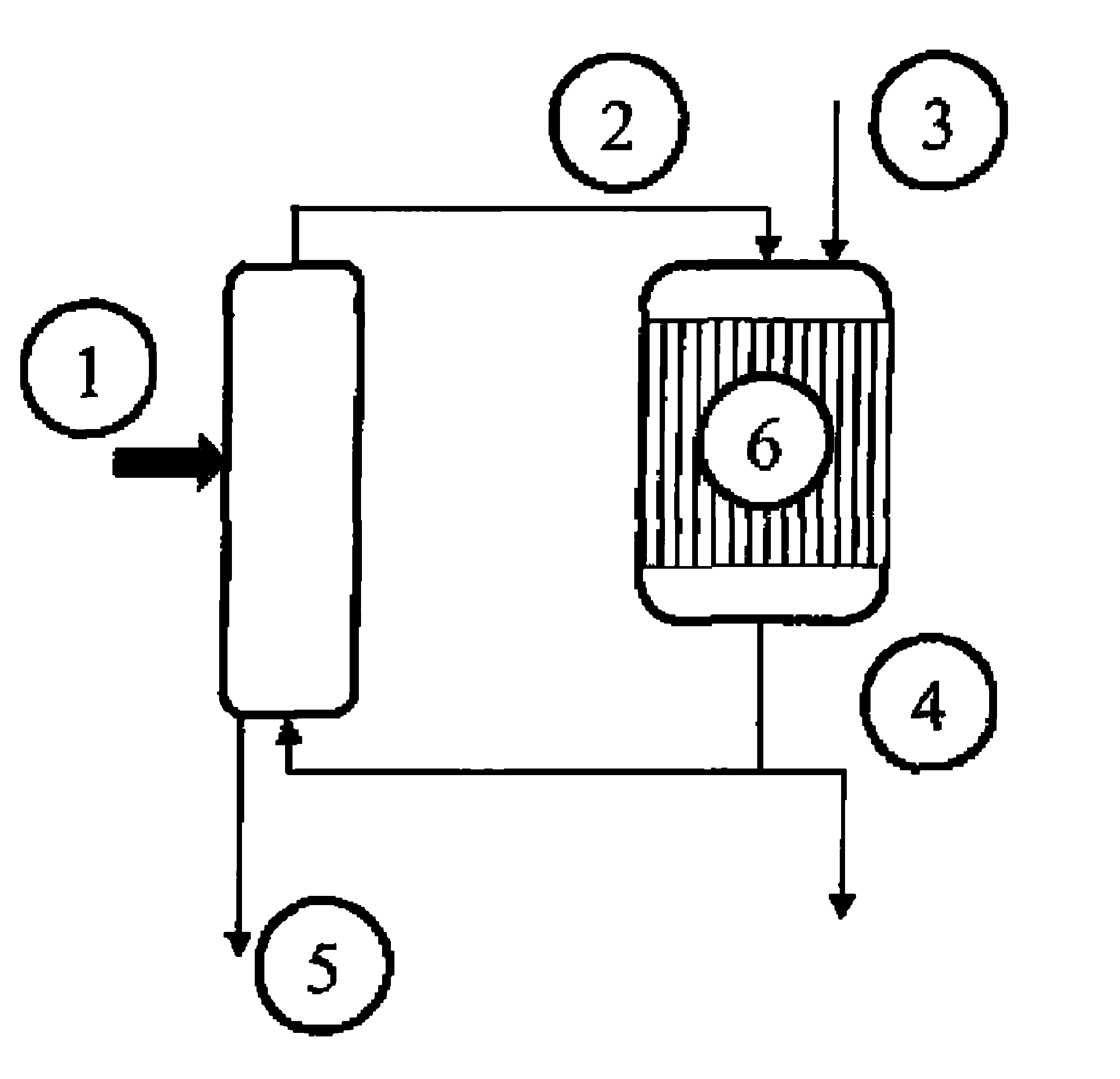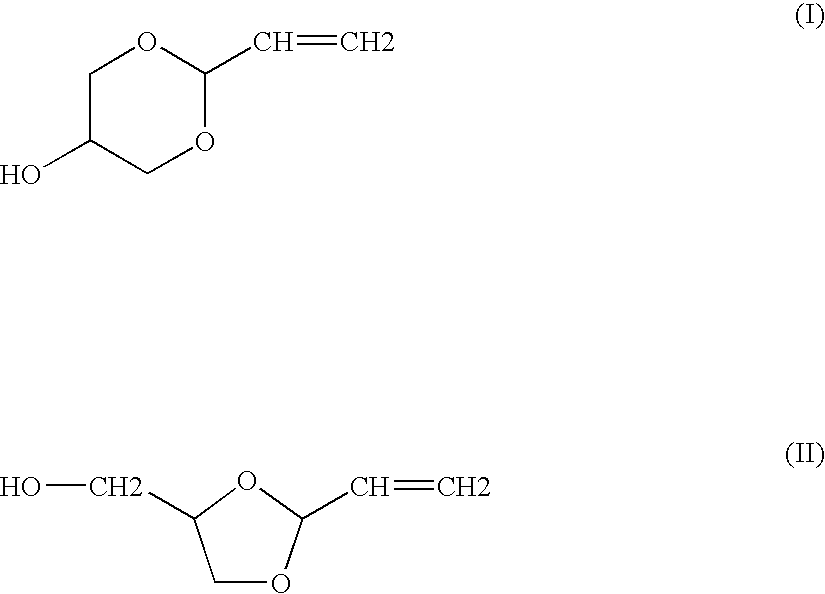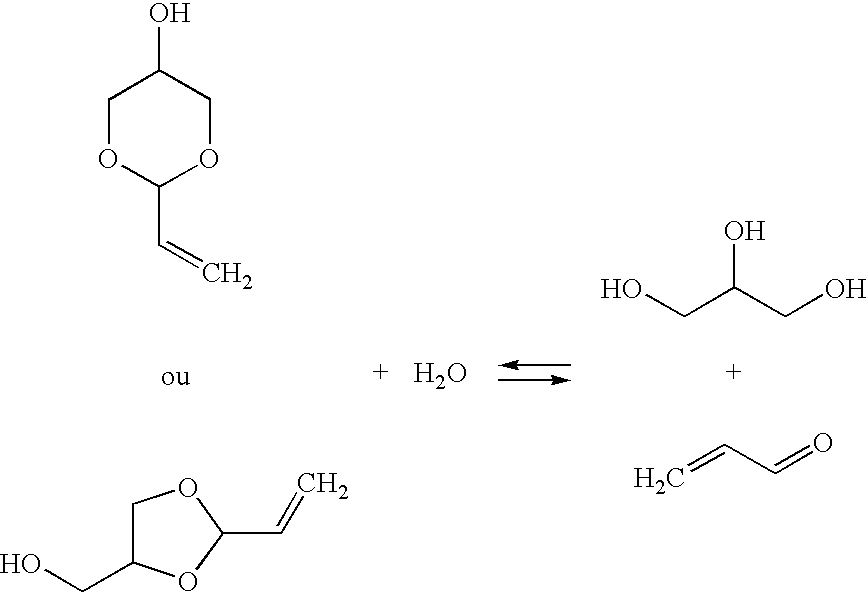Method for synthesis of acrolein from glycerol
a glycerol and acrolein technology, applied in the field of glycerol synthesis, can solve the problems of low yield, low glycerol stability at high temperature, and the conventional evaporation method does not make it possible to have high glycerol partial pressure in the vapor phas
- Summary
- Abstract
- Description
- Claims
- Application Information
AI Technical Summary
Benefits of technology
Problems solved by technology
Method used
Image
Examples
example 1
Preparation of a Mixture of Cyclic Acrolein Glycerol Acetals
[0055]Example 1 of U.S. Pat. No. 5,216,179 is reproduced in order to obtain a mixture containing the cyclic acrolein glycerol acetals, unconverted acrolein and glycerol, and water. After fractionated distillation of the mixture, the conversion rates and the selectivities obtained are substantially identical to those expected.
example 2
Preparation of a Mixture of Cyclic Acrolein Glycerol Acetals
[0056]Example 1 of U.S. Pat. No. 5,216,179 is reproduced, using a 4-liter fixed bed of Amberlyst 15 acidic resin in a loop reactor having a volume of 40 liters. This time, the composition of the reaction loop is 13% of acrolein, 55% of acrolein glycerol acetal, 22% of glycerol, 7% of water and 3% of by-products. The mixture is continuously fed into the circuit at a temperature of 15° C.
[0057]16.2 kg / h of glycerol and 9.9 kg / h of acrolein are continually fed into the loop reactor. Similarly, an equivalent volume of products is continually drawn off from the reactor. A mixture containing the cyclic acrolein glycerol acetals, unconverted acrolein and glycerol, water, and by-products is obtained. A fractionated distillation is carried out on the mixture without the pH being adjusted. The conversion rate for the acrolein added is 66% and that for the glycerol is 64%.
example 3
Preparation of Acrolein
[0058]A bed of catalyst is charged to a pyrex reactor having a volume of 20 ml. The reactor is equipped with a frit in order to retain the catalyst. A mass of 7.2 g of a dehydration catalyst of tungstated zirconia type (Dailchi Kigenso KK, of reference Z1044), diluted with 7 ml of 0.062 mm silicon carbide, is first of all charged. The reactor is then made up with 2 ml of 0.125 mm silicon carbide, 2 ml of 0.5 mm silicon carbide, and, finally, 1.19 mm silicon carbide to the top of the reactor.
[0059]The reactor is then connected to the test plant. The temperature of the catalyst is regulated at 300° C.
[0060]The crude mixture, containing the cyclic acrolein glycerol acetals, obtained in example 2, is mixed with water in proportions of 1 kg / 1 kg.
[0061]13 q / h of the aqueous mixture are then vaporized at 245° C., and then sent to the reactor in the form of a gaseous mixture of acetals / acrolein / glycerol / oxygen / helium-krypton / water, in the proportions 5.5 / 3 / 3.2 / 3.4 / 9.9...
PUM
| Property | Measurement | Unit |
|---|---|---|
| temperature | aaaaa | aaaaa |
| temperature | aaaaa | aaaaa |
| molar ratio | aaaaa | aaaaa |
Abstract
Description
Claims
Application Information
 Login to View More
Login to View More - R&D
- Intellectual Property
- Life Sciences
- Materials
- Tech Scout
- Unparalleled Data Quality
- Higher Quality Content
- 60% Fewer Hallucinations
Browse by: Latest US Patents, China's latest patents, Technical Efficacy Thesaurus, Application Domain, Technology Topic, Popular Technical Reports.
© 2025 PatSnap. All rights reserved.Legal|Privacy policy|Modern Slavery Act Transparency Statement|Sitemap|About US| Contact US: help@patsnap.com



